The Motorola Moto G4 and G4 Plus Review
by Brandon Chester on August 15, 2016 8:00 AM EST- Posted in
- Smartphones
- Lenovo
- Motorola
- Moto G
- Moto G4
GPU Performance
As I mentioned on the last page, moving from Snapdragon 410 to Snapdragon 617 doesn't really lead to a significant improvement in real-world CPU performance. What does improve is GPU performance, which is something that has always been a bit of a problem on low-end and mid-range smartphones. The 2015 Moto G used Qualcomm's Snapdragon 410 SoC. Snapdragon 410 uses Qualcomm's Adreno 306 GPU, which put the 2015 Moto G in a bit of an odd position because that same SoC was used in the significantly cheaper Moto E. Snapdragon 617 uses Adreno 405, which we've demonstrated as providing significantly faster performance than Adreno 306 in past reviews of other devices that use it. It's worth testing a device to ensure everything is working correctly even if you already have results for another device with the same SoC, and so I've run our 2016 GPU benchmarks on the Moto G4.
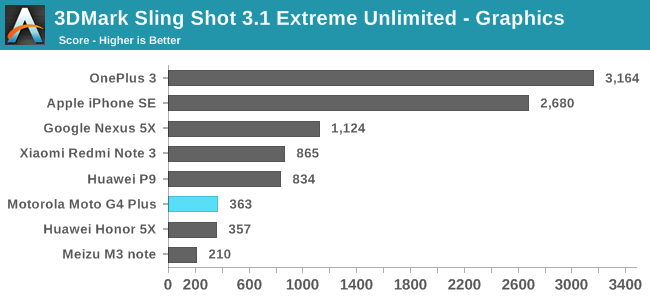
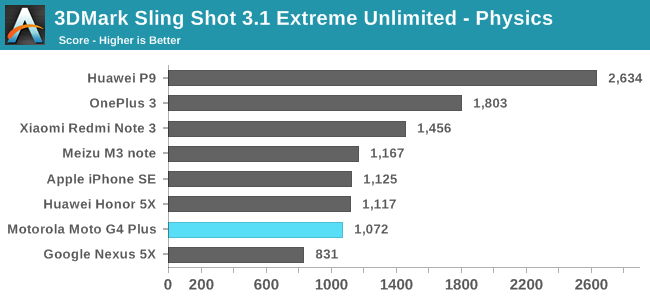
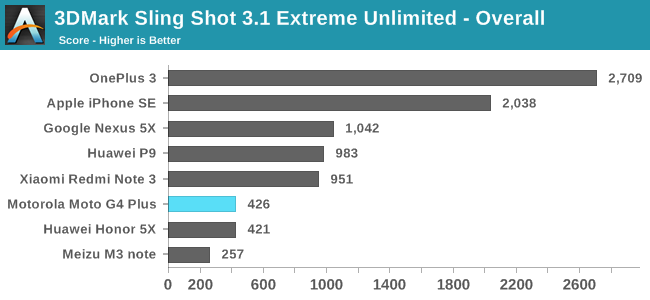
The 2015 Moto G doesn't support OpenGL ES 3.1, and so there's no way to run 3DMark Sling Shot Extreme Unlimited which uses ES 3.1 on Android and Metal on iOS. Snapdragon 617 uses the same Adreno 405 GPU as Snapdragon 615, and you can see in the results that the performance is right in line with the Huawei Honor 5X which uses Snapdragon 615. For a mid-range phone this is generally good performance, but once again the Xiaomi Redmi Note 3 sits far ahead of the rest of the mid-range smartphones, including the Moto G4.
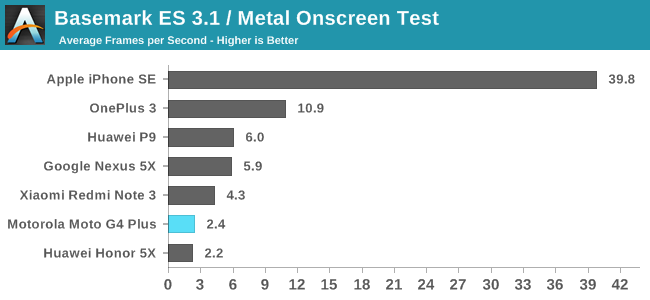
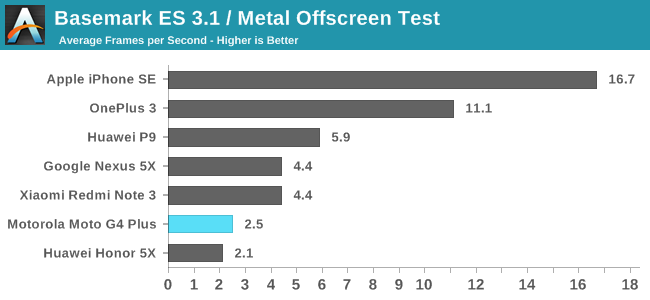
The situation in BaseMark ES 3.1 is the same as 3DMark, with the G4 Plus achieving roughly the same performance as the Huawei Honor 5X. The Xiaomi Redmi Note 3 with its Adreno 510 GPU ends up being a little over 75% faster, which is a huge improvement even if both devices technically don't get close to a playable frame rate in this very heavy test.
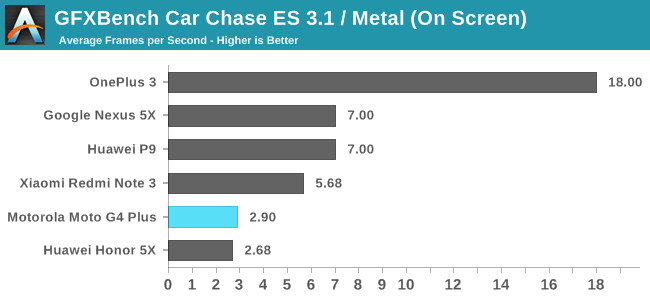
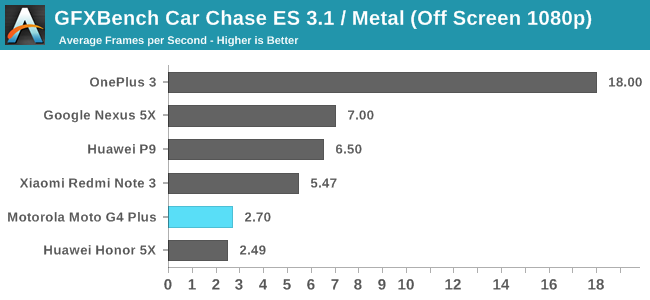
In GFXBench Car Chase it's the story is the same. The Moto G4 Plus is in line with other Adreno 405 devices, but the question is really whether or not that's good enough for a device launching this late into 2016.
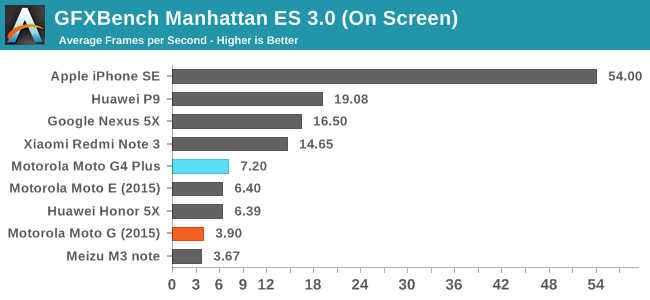
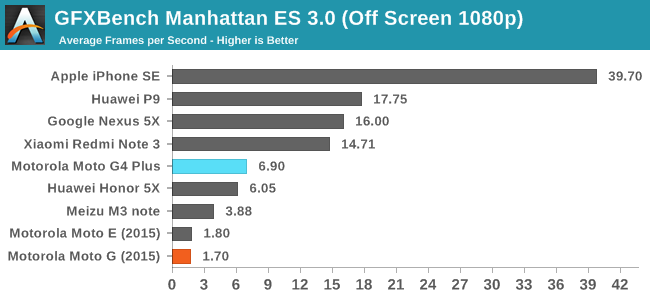
We've generally moved to Manhattan ES 3.1 / Metal for our reviews, but in cases like this where a device's predecessor doesn't support OpenGL ES 3.1 it's helpful to bring back Manhattan ES 3.0 to do a direct performance comparison. As expected, the Moto G4 is much faster than the 2015 Moto G, with on screen performance being about 85% faster despite the move from 720p to 1080p. and off screen performance being over four times faster.
It's clear that the Moto G4 provides much better GPU performance that the 2015 Moto G. However, much like the CPU benchmarks, I keep looking at the charts and seeing the Xiaomi Redmi Note 3 sitting well above the Moto G4. Adreno 405 is much better than Adreno 306, but Adreno 510 is two times faster than Adreno 405. I feel like the Moto G4 is simply launching too late for this kind of performance to be competitive, as it's tied with the Honor 5X which was launched at $200 nearly a year ago. While I don't mean to take away from the fact that the Moto G4 does provide faster GPU performance than its predecessor, I think there are devices right around the corner that are going to make a mid-range smartphone with Snapdragon 617 look decidedly last generation.
NAND Performance
NAND performance is still an area of concern on mid-range smartphones, but the situation has gotten better in recent times. The 2015 Moto E was an example of a device with very poor NAND performance, but the 2015 Moto G was significantly faster across the board. Motorola is still using eMMC memory, but there's definitely room for improvement over the 2015 Moto G even when sticking with an eMMC storage solution. To evaluate the Moto G4's storage performance I've run AndroBench 4.0 on both the 16GB Moto G4 and the 64GB Moto G4 Plus.
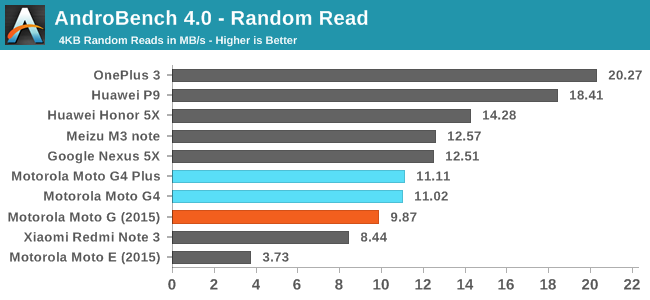
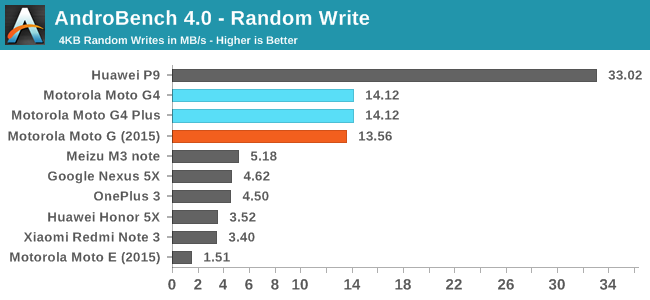
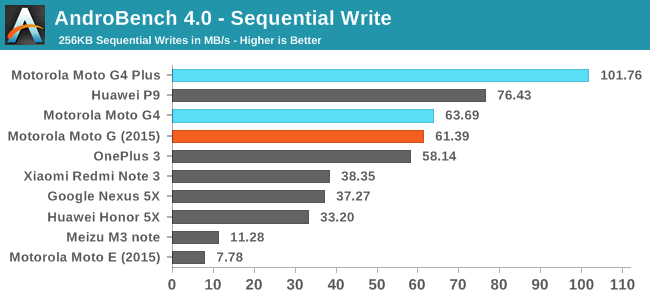

Among mid-range devices, the 64GB Moto G4 Plus performs very well. Random write results are ahead of all other devices on the chart except the Huawei P9, which isn't really a mid-range device and is just there for SoC comparisons. In the sequential write test the Moto G4 leads, which is due in part to the larger capacity allowing greater write parallelism. Sequential read performance is very good as well, although obviously not competitive with UFS 2.0 storage solutions like the one used in the OnePlus 3.










94 Comments
View All Comments
Geranium - Monday, August 15, 2016 - link
You know, even on same platform different version gives different result. PC Mark running on Android 4.4 and Android 5.1 will show different results on same device let alone different platform. And many benchmark favours iOS.Brandon Chester - Monday, August 15, 2016 - link
It's not surprising that two versions of Android with completely different app runtimes have different performance. Nobody programs their benchmarks to favor a given platform. When iOS devices do well in a given test it's because they have faster hardware/software than competing Android devices, and when Android devices do well it's because they have faster hardware/software than competing iOS devices.invinciblegod - Monday, August 15, 2016 - link
What source states that benchmarks discriminate against android? If you are saying that iphones consistently get better scores and that is your basis, then I think the problem isn't the benchmarks. Also, anandtech has many custom benchmarks so there is that.Brandon Chester - Monday, August 15, 2016 - link
This isn't a review of Snapdragon 617, it's a review of the Motorola Moto G4. The applications on the Moto G4 use the available APIs on the Android platform, and applications on the iPhone SE use the APIs available on the iOS platform. If one platform's APIs are better/faster (and as a mobile developer I will tell you that is very much the case) then apps using them will be faster than their counterparts on the other platform.Performance is not independent of software. We have tests like SPEC for SoC reviews, but for a smartphone it's perfectly valid to compare across APIs and operating systems when that reflects what the apps on those platforms also use. For example, modern games on iOS use Metal, and games on Android use OpenGL ES 3.0/3.1. Why would it somehow be unfair or not comparable to run a benchmark that uses Metal on iOS and OpenGL ES on Android? Isn't that exactly representative of the real apps that those benchmarks are trying to emulate the actions of? You cannot isolate the performance of a smartphone from its operating system and APIs. Tests that are mostly software-agnostic can be interesting from an academic point of view, but such tests are worthless when describing the performance of an actual device.
Geranium - Monday, August 15, 2016 - link
On same hardware Metal will performe better hhan OpenGL ES.Aren't we use same setup to benchmark cpu, gpu or SSD. Even use same version of OS.
Brandon Chester - Monday, August 15, 2016 - link
Yes, and games on iOS use Metal while games on Android use OpenGL ES. The benchmark reflects the performance of the device when playing games, which is exactly what they're supposed to do.greyhulk - Monday, August 15, 2016 - link
Unless I missed it, I didn't see much mention of the overheating issues that a lot of people are reporting. Did you encounter any during your testing? It seems to occur during camera use or when the phone is run really hard.Brandon Chester - Monday, August 15, 2016 - link
That could be why PCMark battery won't complete, but I never noticed the phone getting uncomfortably hot during my usage. I never even thought to monitor temperatures on an S617 device.mrdude - Monday, August 15, 2016 - link
The only time I've noticed that it gets hot is when it's turbocharging.zeeBomb - Monday, August 15, 2016 - link
Ah yes, Brandon delivered. I've been waiting for this review for WEEKS!